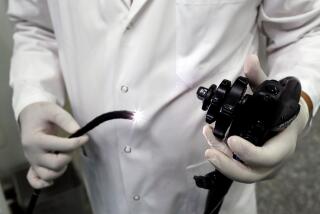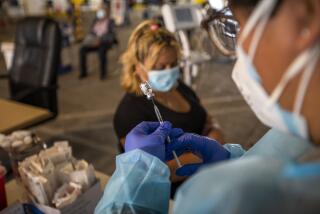Study bolsters evidence that screening reduces lung cancer deaths
- Share via
Screening smokers and ex-smokers with spiral CT scans can reduce lung cancer deaths by 20% without triggering too many dangerous or unnecessary tests that sometimes result from cancer screening programs, researchers reported Wednesday in the New England Journal of Medicine.
After conducting a more thorough analysis of data from a trial involving more than 53,000 patients, the researchers found that even though the scans produced many false-positive results — affecting 39% of those who were screened three times — there were few serious complications resulting from them.
The $250-million trial, funded by the National Cancer Institute, is the first to conclusively demonstrate that screening can reduce deaths from lung cancer, experts said. An estimated 157,000 Americans die from lung cancer each year, and the new study suggests that as many as 27,000 of those lives could be saved by screening.
“It’s very important to show the proven benefit of reduced mortality, but it’s equally important to show that there are no significant harms due to screening,” said Dr. Denise R. Aberle of UCLA’s Jonsson Comprehensive Cancer Center, one of the principal investigators of the study. The benefit of screening was reported last fall based on preliminary data, and “we have now shown the risk side of the equation,” she said. “That was not previously known.”
The results were widely hailed as a breakthrough in preventing lung cancer deaths. Dr. Otis Brawley, chief medical officer of the American Cancer Society, and others suggested it was second in significance only to the surgeon general’s 1964 report linking smoking to lung cancer in terms of reducing lung cancer deaths.
The results are beginning to sway some experts who were previously skeptical about the value of such screening. Dr. Ned Patz, a radiologist at Duke University Medical Center who participated in the research, noted that “before, we had no data that showed any benefit [from screening] whatsoever.” Now, he said, the data show that “at least some groups will benefit.”
The primary questions now, he said, are how much widespread screening will cost and what effect it will have on other medical resources. Medicare now pays about $300 for a CT scan, but further testing resulting from a positive finding will cost many times that amount.
Some of those questions may be answered in future reports to come out of this research, which, among other things, will attempt to calculate the cost-benefit ratio and to better define which individuals would be helped most by screening.
Other major lung cancer screening studies are underway in Europe, and results from those also will help clarify the picture, experts said.
Dr. Bruce Johnson of the Dana-Farber Cancer Institute in Boston, a board member of the American Society of Clinical Oncology, noted that his group and others — including the National Cancer Institute, the American Cancer Society and the American College of Chest Physicians — will develop new screening guidelines based on the results, but may wait for further reports from the group and results from Europe before issuing them.
The American study, called the National Lung Screening Trial, enrolled 53,454 smokers and ex-smokers between the ages of 55 and 74 beginning in 2002. All the participants had smoked for at least 30 pack-years — that is, one pack a day for 30 years, or two packs a day for 15 years, and so on.
Participants were randomly assigned to receive either conventional chest X-rays or spiral CT tests once a year for three years. Low-dose spiral CT imaging, also known as helical CT imaging, can produce a complete three-dimensional image of the chest cavity in the duration of one held breath, with a radiation exposure similar to that of a mammogram. Subjects were then monitored for a total of seven years.
The National Cancer Institute announced in November that the CT exams yielded a 20% reduction in deaths from lung cancer. A total of 354 lung cancer deaths had occurred among those in the CT arm of the study, compared with 442 in the chest X-ray group. The data monitoring board recommended that the study be stopped because it had proved the value of screening. Further details were withheld, however, until Wednesday’s report.
Aberle said that about 320 smokers and ex-smokers need to be screened by CT to prevent one lung cancer death. That compares very favorably to results announced this week for mammography, which showed that between 414 and 519 women had to be screened to prevent one death.
Both forms of imaging detected early stages of adenocarcinomas, which begin in cells that line the lungs, and squamous cell carcinomas, which arise from the thin, fish-scale-like cells that line the passages of the respiratory tract. But they were detected at the earliest stages more frequently by CT imaging. Such cancers account for 85% of lung tumors.
But small-cell lung cancer, aggressive tumors that grow in the tissues of the lungs, were rarely detected by either technique. That was expected, Aberle said, because such tumors typically metastasize before they are large enough to be seen.
On average, 24.2% of the CT tests and 6.9% of the chest X-rays were positive. About 39% of those who had three CT scans had at least one positive test. Overall, 96.4% of the positive CT scans and 94.5% of the chest X-rays were false positives. False positive results were typically eliminated by follow-up scans that showed no change in nodule size over time.
Adverse events from false positives were relatively minor and occurred in fewer than 2% of cases with either type of screening. Among those who had complications, 16 in the CT group died within 60 days of a follow-up procedure (including 10 who died of lung cancer) and 10 in the chest X-ray group died (all from lung cancer).
Arthur A. Levin, director of the Center for Medical Consumers, a nonprofit group that has frequently criticized excessive testing, cautioned that the study participants may not have been followed long enough to achieve definitive results. If cancers are detected earlier, he said, the short-term survival rate will be higher because the clock starts ticking on them sooner, but the long-term survival might not be changed.






